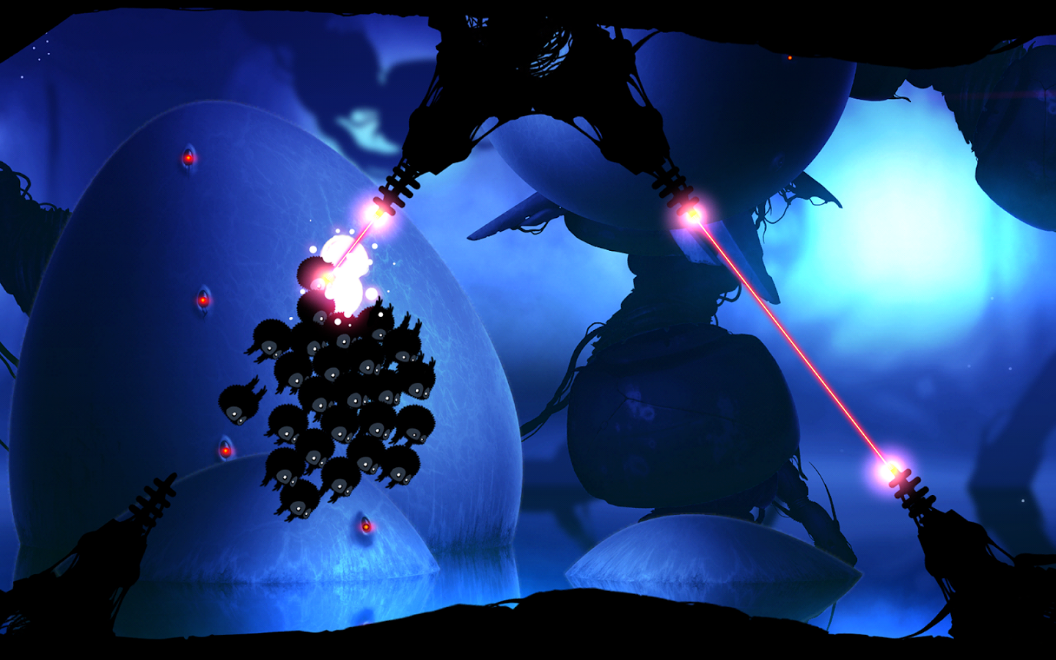Blog
Learner-Centered Design: 3 Quick Ideas for e-Learning
By Ellen Burns-Johnson, Instructional Designer / @ellenBjohnson I find the mobile game BADLAND really engaging. I've beaten more than 80 of the ...


How to Use Context to Create Meaning in Learning Games
By Ellen Burns-Johnson | November 05, 2015 | Custom Learning | 0 Comments
By Ellen Burns-Johnson, Instructional Designer / @ellenBjohnson
.png?width=125&name=Ellen(250).png)
I find the mobile game BADLAND really engaging. I've beaten more than 80 of the game's 100 single-player levels, and spent close to ten hours flapping my fuzzy little clone wings through obstacle courses across a dreamy alien landscape.
From a gaming perspective, I think BADLAND is a great success. What about from an instructional design perspective? Can I transfer the skills from BADLAND into the real world?
Not at all, unless I find myself reincarnated as a furry blob on a 2D planet, dodging lasers and flying buzz saws.
 I hope I never have to face this situation in real life.
I hope I never have to face this situation in real life.
Context is what makes interactivity appropriate for one purpose and meaningless when applied to another.
There has been a lot of discussion in the instructional design industry about how we can draw inspiration from video games to create more compelling e-learning. In this blog post, I'm going to explore how context, as a component of e-learning design, can guide our decisions about what interactivity is appropriate for learners.
Context is an essential design element
The term "context" itself has varying meanings depending on the context in which it's used. In rhetoric, it refers to the words and sentences that precede a quote. In fiction, it might refer to the setting.
At Allen Interactions, we refer to Context as one of four design elements in a learning experience (Context, Challenge, Activity, and Feedback). In e-learning, Context can encompass graphics, animation, narrative, characters, sound effects, social network functionality, or other aspects of the design that help make the experience relevant to the learner.
A compelling Context can aid learning transfer, boost retention, and draw learners into the experience, so it's valuable whether you're building a complex simulation or game, a branching conversation scenario, or a simple page-turner.
Context in learning games
Despite its importance, we see a lot of learning games with weak Context elements, or no Context at all. Here's how to tell the difference between them.
-
A non-contextualized game or interaction might help learners develop knowledge or practice a skill, but the Context of the game has no resemblance to the real-world environment or circumstances in which the skill or knowledge will be applied.
Sports analogies and quiz shows are often used as templates for non-contextualized learning games. Picture an interaction that intersperses multiple-choice questions about food safety in between goal kicks on a soccer field. Some consider "gamification" to be the very process of layering on game mechanics in this way, but the definition of gamification is another blog post entirely.
-
Contextualized learning games and interactions develop knowledge or help learners practice skills, but some or all of their contextual elements resemble real-world conditions.
The Magoosh Vocabulary Builder app provides examples of each word used within a sentence, which puts the "game" in Context of the real-world activity of reading. Wheelchair Securement: The Center for Transit e-Learning (C-TEL), a course that Allen Interactions developed for River Cities Public Transit, uses graphic and audio components to simulate the Context of a vehicle.
Which approach is better for learners?
At first glance, non-contextualized learning games appear to have a number of advantages. They often can be re-purposed to accommodate different content, saving on development costs. Plus, games and gamification are often considered to be a means of boosting learner engagement.
However, if you're building learning games to help learners establish new skills, then your goal isn't just engagement but learning transfer.
I've seen non-contextualized games used effectively as knowledge checks and refreshers, but most of the training I'm asked to design is intended to help learners construct new knowledge and develop new skills. Contextualized interactions are better for these purposes.
5 tips for developing Context
Whether you're designing an interaction yourself, or assessing what solutions will work for your learners, it can be difficult to determine what level of Context is necessary. Fortunately, incorporating just a few Contextual elements can have a big impact.
Dr. Karl Kapp made a great suggestion during a #lrnchat Twitter session last March:
"#gamification doesn't need to be expansive, small elements, like starting with challenge or incorporating a character can work"
Here are five more tips for considering Context within learning interactions:
1. Think about the setting.
Use the real world for inspiration, or have Context be the real world by means of emerging technologies, like mobile augmented reality. This doesn't mean you have to avoid fictional elements, though. Fictional situations and settings can allow learners to engage with tough, even controversial material without getting distracted by real-world implications.
2. Go beyond the physical environment.
See Dr. Kapp's quote above. It doesn't take a massive, fleshed-out 3D world to provide a strong Context – characters, stories, and sounds can all be used to great effect. The Context of the HTML game SPENT is a story, supported by simple icons and symbols.
3. Incorporate consequences.
Did you see Sunday night's episode of The Walking Dead? No spoilers here, I promise – I just want to point out that nothing makes a fictional environment feel authentic like consequences do. Allow learners to make (or watch) realistic decisions, then let them experience what happens.
4. Don't rely on novelty.
Know the reason for each element of the Context. Will the timer build engagement, and if so, how? Will that animation add emotional weight to the experience? Is that sound effect helpful in drawing attention to the Resources button, or is it there because someone thought it sounded "cool"? Every part of the interaction should have meaning or serve a specific purpose.
5. Support the context with UI, as appropriate.
While Context and user interface are not synonymous, the Context can certainly inform the interface, and the interface can support the Context.
For more inspiration, take a look at Ethan's Context Design Road Map available on Allen Outreach or Dr. Kapp's guest blog post, 5 Reasons Why Game-Based Learning Should Matter to Organizations.
LIKE WHAT YOU'VE READ? CLICK THIS READY-MADE TWEET TO SHARE THE KNOWLEDGE!
CLICK TO TWEET: How to Use #Context to Create #Meaning in #Learning #Games http://hubs.ly/H01mLlZ0 #aiblog by @ellenBjohnson

About the Author: Ellen Burns-Johnson
Ellen Burns-Johnson has over a decade of experience in the education and training industries. She has crafted the instructional strategy and design for dozens of major initiatives across diverse topics, from classroom safety to IT sales. Emphasizing collaboration and playfulness in her approach to creating learning experiences, Ellen’s work has earned multiple industry awards for interactivity and game-based design. Ellen is also a Certified Scrum Master® and strives to bring the principles of Agile to life in the L&D field. Whether a client is a Fortune 100 company or a local nonprofit, she believes that the best learning experiences are created through processes built on transparency between sponsors and developers, empirical processes, and respect for learners. Outside of her LXD work, Ellen plays video games (and sometimes makes them) and runs around the Twin Cities with her two mischievous dogs (ask for pictures).
Comments
Would you like to leave a comment?
Related Blog Posts

By: Ellen Burns-Johnson | May, 2014
Category: Custom Learning

Blog
Oh What a Feeling: Emotion and Learner Engagement
By Ellen Burns-Johnson, Instructional Designer / @ellenBjohnson I find the mobile game BADLAND really engaging. I've beaten more than 80 of the ...
By: Ellen Burns-Johnson | Oct, 2014
Category: Custom Learning

Blog
Q&A: Three Quick Ideas for Creating Interactive e-Learning
By Ellen Burns-Johnson, Instructional Designer / @ellenBjohnson I find the mobile game BADLAND really engaging. I've beaten more than 80 of the ...
By: Ellen Burns-Johnson | Apr, 2015
Category: Custom Learning, Strategic Consulting


